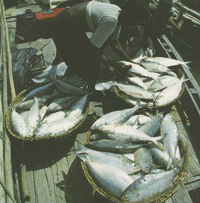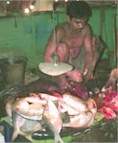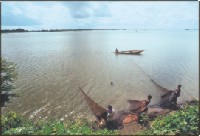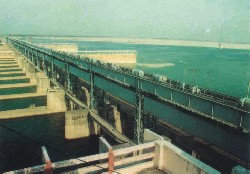HILSA Tenualosa ilisha King of Fishes - Going to Extinct?
 |
 |
| English name | Hilsa shad |
| Latin name | Tenualosa ilisha |
| Physical features | Bony fish with moderately deep body , laterally compressed with 30-33 scutes on the ventral side. Abdominal part keeled with strong scutes. Adult size: 35-48 cm. Adult average weight: 1.4 Kg |
| Geographical distribution | Upper Bay of Bengal region, Persian Gulf, Arabian Sea, South China Sea |
| Habitat | Coastal shelf, Brackish water estuaries and Fresh water rivers |
With one of the highest population densities of any country in the world, a rising birth rate, destitution, and hunger, Bangladesh desperately depends on this nourishment. Hilsa shad is a major food fish in Bangladesh and is sacred according to Hindu mythology. It is hailed in Bengali (Bangladesh's official language) as "macher raja-ilish", meaning "Hilsa shad-the king of fish." Its fisheries employ 40 percent of all fishers and, directly or indirectly, 2 percent of the entire country. Their proper management, based on a sound understanding of their life history, is therefore vital.
Life History
Hilsa shad, like the American shad (Alosa sapidissima), is anadromous: it feeds and grows mainly in marine waters, migrating to fresh water for the express purpose of spawning. Although migration distances of 50-100 kilometers (31-62 miles) are more common, Hilsa shad are known to migrate 1,200 kilometers (740 miles) upstream to spawn in the Ganga system.
The migratory strategy and breeding status of Hilsa shad
The migratory strategy of Hilsa shad is mainly initiated during the breeding season, which is triggered up with flow of fresh water effluent from the inland rivers, and naturally it occurs with the commencement of the south-west monsoon and consequent flooding of all the major rivers draining down to The Upper Bay of Bengal. But still exact spawning season for the species is a controversial matter and mostly it has been reported to vary from a few months to year around, and this duration depends on river or differents parts of the regions where the species is distributed.
The hilsa shad deposits its eggs in fresh water; when they hatch, the larvae and juveniles migrate to sea over several months, feeding and growing en route. At this early stage of their life they are known locally as "Jatka," and range from 4-15 centimeters (1.6-6 inches) in length. They are abundant from February to May in the foreshore and riverine waters of Bangladesh's deltaic rivers, including the Padma and the Meghna.
Once widespread, Tenualosa toll is now found only in the estuaries and adjacent coastal areas of Sarawak, T. thibaudeaui only lives in the lower and middle Mekong system, and is believed to be close to extinction, and T. macrura, lives in the coastal waters of Sumatra and Borneo.All five species are the subject of important and valuable fisheries, but all, with the exception of Hilsa (Tenualosa ilisha), have suffered massive declines in catches.
A research project in 1993 reveled that the species only lives two years, that it changes sex - male first year, female second year, that it only spawns in three very specific localities, and that it is possible to culture the species for re-stocking, has enabled the Sarawak Government to save the species and the fishery.
Supply of hilsha fish decreases abruptly

Now hilsha of medium size known as Kishore or Tempo in the locality does not exceed over 300 grams. Earlier on an average hilshas of 700 to 800 grams were brought in the market. But sellers and buyers alleged that good-sized hilsa fish have been smuggled to India from the river before they were brought to the wholesale market. Bara Station Fish Ghat is the main centre for hilsa trading with other parts of the country where about 1,000 labourers are engaged.
The value of the hilsa shad fishery could be increased dramatically by simply protecting the juveniles. In fact, if 30 percent of the present catch were untouched, it could mature to an additional value of 5-7.5 million Bangladeshi Takas (1.2-1.8 million U.S.dollars). Many, including the United Nations Food and Agriculture Organization (FAO), support a ban on jatka fishing during their seaward migration, especially in their nursery grounds. Two nurseries have been identified. The largest, on the Meghna River, extends from Shatnal south to Hazimara; the other extends from the Kuakata seashore in the Patuakhali district, to Dublar Char of the Khulna district.
To make a ban practical, fishers must be taught to recognize the difference between Jatka and the Indian river shad (Chapilla). Jatka has a shallower body, larger scales, and fewer than 70 scales along its lateral line, whereas chapilla has more than 100.
Mature Hilsa Shad
Though Hilsa shad is commonly available in the many southern districts of Bangladesh, most are netted at landing platforms within just two: the Barisal district located on the west bank of the Meghna River, and the Chandpur district, located on the Meghna's east bank. The marine catch is processed at Bangladesh Fisheries Development Corporation landing stations in the coastal cities of Chittagong and Cox's Bazar. At the time of peak catch, temperatures rise to 36-41 degrees Celsius (97-106 degrees Fahrenheit), and, because ice is in short supply (and transport facilities are few), much of the catch is lost each year.

The Future
- Educate fishing communities about the value of a ban on jatka fishing
- Support a community-based program to monitor and enforce a jatka fishing ban on all major rivers during the jatka outmigration; and
- Establish, through field surveys, the downstream migration patterns of hilsa and their fishing mortality.
- Stop overfishing during peak spawning migration
- Register non-mechanized fishing boats and regulate fishing gear
- Estimate monthly landings for each locality and
- Remove bamboo fences which fishers erect to block the hilsa's river migration.